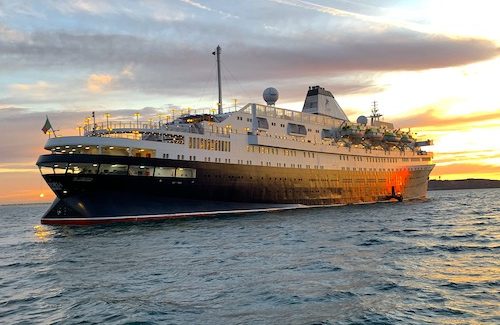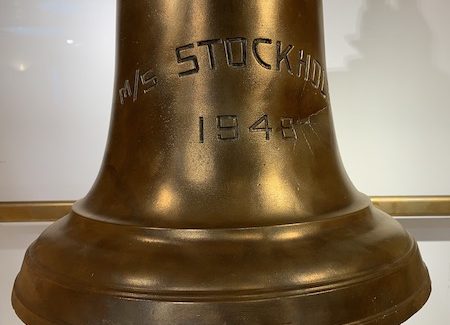Cruise Trivia: Why is this bell displayed on the Astoria cruise ship?
This may be an easy one for some people. But on a recent cruise aboard the historic Astoria, I heard several fellow passengers question why the large dented Stockholm ship bell was in a place of honor aboard the Astoria.
By the end of the cruise, I hope they knew. If not, they should have attended the fascinating program given by ship historian Peter Knego in which he shared the haunting stories of the Stockholm and the Astoria.
Don’t look at the answer below until you’ve formulated your own response. Congratulations, if you are correct. You must be a trivia expert and a dedicated cruise ship lover. Or maybe you have cruised on the Astoria and heard the fascinating story.
If you didn’t know the answer, you might want to book a cruise aboard the Astoria. And do it quickly. The 72-year-old cruise ship joined the Cruise and Maritime fleet in 2015.
However, CMV has announced that 2020 will be the ships farewell season. Sad.
*
*
*
(Answer)
The Astoria is the former Stockholm so that bell is right where it belongs. Launched in 1948 and originally christened the Stockholm, the ship has had many reincarnations over its 72 years.
Built as part of the Swedish America Line, the ship has had a storied life, including a notorious collision with the Andrea Doria in 1956. She also sailed behind the Iron Curtain as an East Germany cruise ship where many defectors would jump overboard seeking asylum when the ship navigated Western waters. She also served as a barracks ship for asylum seekers in Norway during the 80s and survived being attacked by pirates in 2006.
Bad weather, incorrect communication and wrong maneuvers seemed to combine for a maritime tragedy when the Stockholm and the Andrea Doria collided. On the fateful day of July 25, 1956, the Andrea Doria was on her way to New York on her 101st transatlantic crossing. She carried 1,134 passengers and 572 crewmembers. Off the coast of Nantucket, Massachusetts, the Andrea Doria encountered thick fog.
At the same time, the Stockholm was leaving New York for her homeport of Gothenburg, Sweden, with 747 passengers and crewmembers aboard. By about 10:30 p.m., the two ships were approaching one another from opposite directions off the foggy coast of Nantucket. Both ships were trying to shave a bit of sailing time off their journey when the weather conditions should have encouraged more caution.
Neither ship was aware of the other until it was too late. Both tried to avoid a collision but the Stockholm’s thick icebreaker bow sliced through the Andrea Doria’s starboard side, leaving a gaping hole and ripping open seven of her 11 decks.
Five Stockholm crewmembers were killed by the impact and Andrea Doria passengers were swept into the sea.
Although the Stockholm was in no danger of sinking, the larger Andrea Doria was listing more than 20 degrees on its starboard side, allowing seawater to spill through the compartments.
To make it even worse, the Andrea Doria’s eight portside lifeboats couldn’t be launched because the ship was capsizing
While the Stockholm began rescuing passengers and other smaller boats arrived to help, a massive French ocean liner the Ile de France answered the distress call and used floodlights and lifeboats for rescues in the darkness.
At 10:09 a.m. the next morning, the Andrea Doria disappeared beneath the Atlantic. The Stockholm made it back to New York under its own power with 545 Andrea Doria survivors onboard. Forty-six passengers died on the Andrea Doria.
As for that dented bell that once graced the bow of the Stockholm, it also went down with the Andrea Doria, trapped in the gaping wound of the Italian beauty. No one thought it would ever be seen again.
As years went by, the wreck of the Andrea Doria became a challenging and dangerous dive site. Known as the Mt. Everest of diving because of its poor visibility and unpredictable currents, the wreck has claimed more than a dozen divers trying to explore its watery grave. Slowly, some artifacts were recovered from the sunken ship, including the bell from the Stockholmherself.
After being traded around here and there, the bell was bought by Cruise & Maritime Voyages and returned to the name-changed Stockholm, now the Astoria.
Seems appropriate that the ship and her bell have been reunited in what may be the final days of the historic Stockholm’s long cruising career.
Story and Photos by Jackie Sheckler Finch
















View Recent Comments